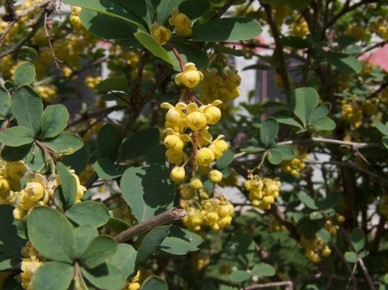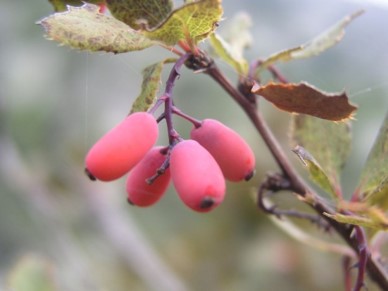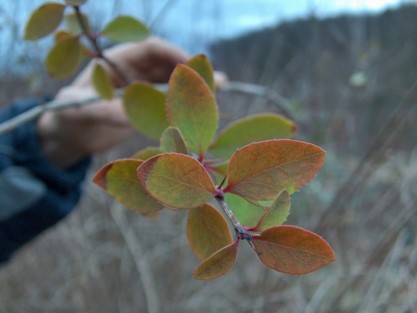Scientific classification
| Kingdom: | Plantae |
| Clade: | Tracheophytes |
| Clade: | Angiosperms |
| Clade: | Eudicots |
| Order: | Ranunculales |
| Family: | Berberidaceae |
| Genus: | Berberis |
| Species: | B. vulgaris |
Characteristics

Barberry (Berberis vulgaris L.) is a deciduous shrub from the barberry family of the same name (Berberidaceae). It grows up to 3 meters in height, forming branches that are like twigs, reddish in their youth, bridle, later woody, become gray-brown and deeply furrowed. The root system is well developed.
The buds are small, only 1 mm in size. The leaves are alternate, ovate or elliptical, 4 cm long, 2 cm wide, finely serrated, ciliate hairy, located on short stalks arranged in bundles. In autumn, they become reddish. The flowers are bisexual, regular, small, yellow-orange, gathered 8-25 in hanging clustered inflorescences up to 5 cm long.
Fruits are smaller, elongated berries, up to 12 mm long and red in color, containing one to three seeds. They hang in clusters on short stalks and ripen in late August and September.
Habitat – Range
It is widespread in southern and central Europe, northern Africa, and western Asia. It grows most often in light forests, along forest edges and thickets from the lowlands to the mountain belt. We propagate it by seeds or even better by cuttings that we take from adult plants during the summer. Prefers sunny areas or light shade, dry, rocky, fertile, basic to calcareous soils.

Etymology
The Latin name of the genus Berberis comes from the Arabic name for the fruit of barberry. The name of the species vulgaris means common, common. The name of the barberry species is given because of the bark which shows an intense yellow color when cut.


Usage
The flower is harvested during flowering in May and June, the leaves in summer, the berries when ripe in late summer, the bark in summer and autumn, and the root in late autumn.
Young leaves can be used raw in salads or dried and used as tea.
The berries can be eaten raw but have a sour taste, and are usually processed into jam. They are collected without a stalk and if they are dried, they must retain their natural color when dried.
The root is the most healing part of the plant. It is used to treat icterus, against the formation of sand and stones, allows their excretion from the kidneys and bladder, cures gout. It promotes the secretion of wires, dilates blood vessels and thus improves circulation and lowers blood pressure.



